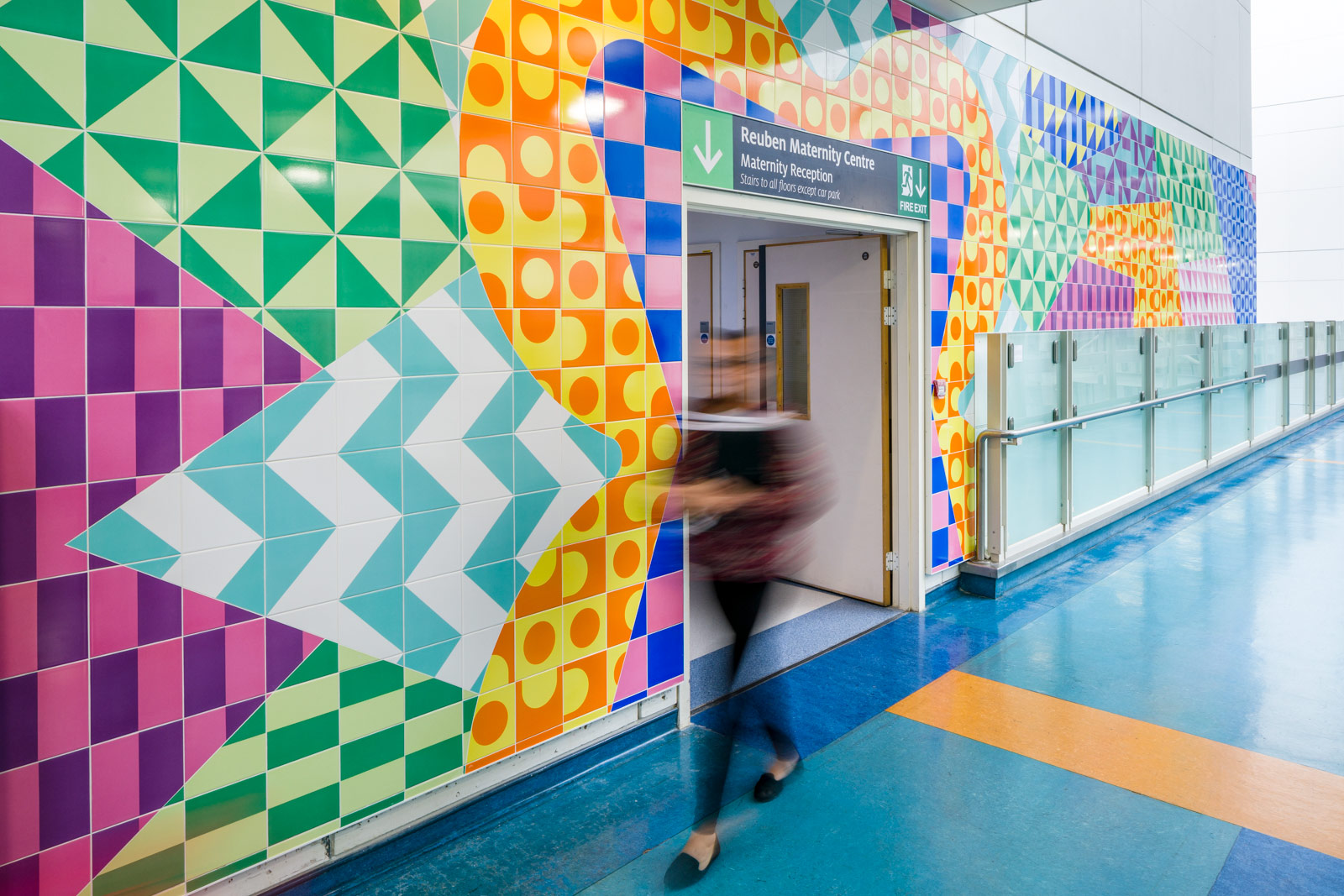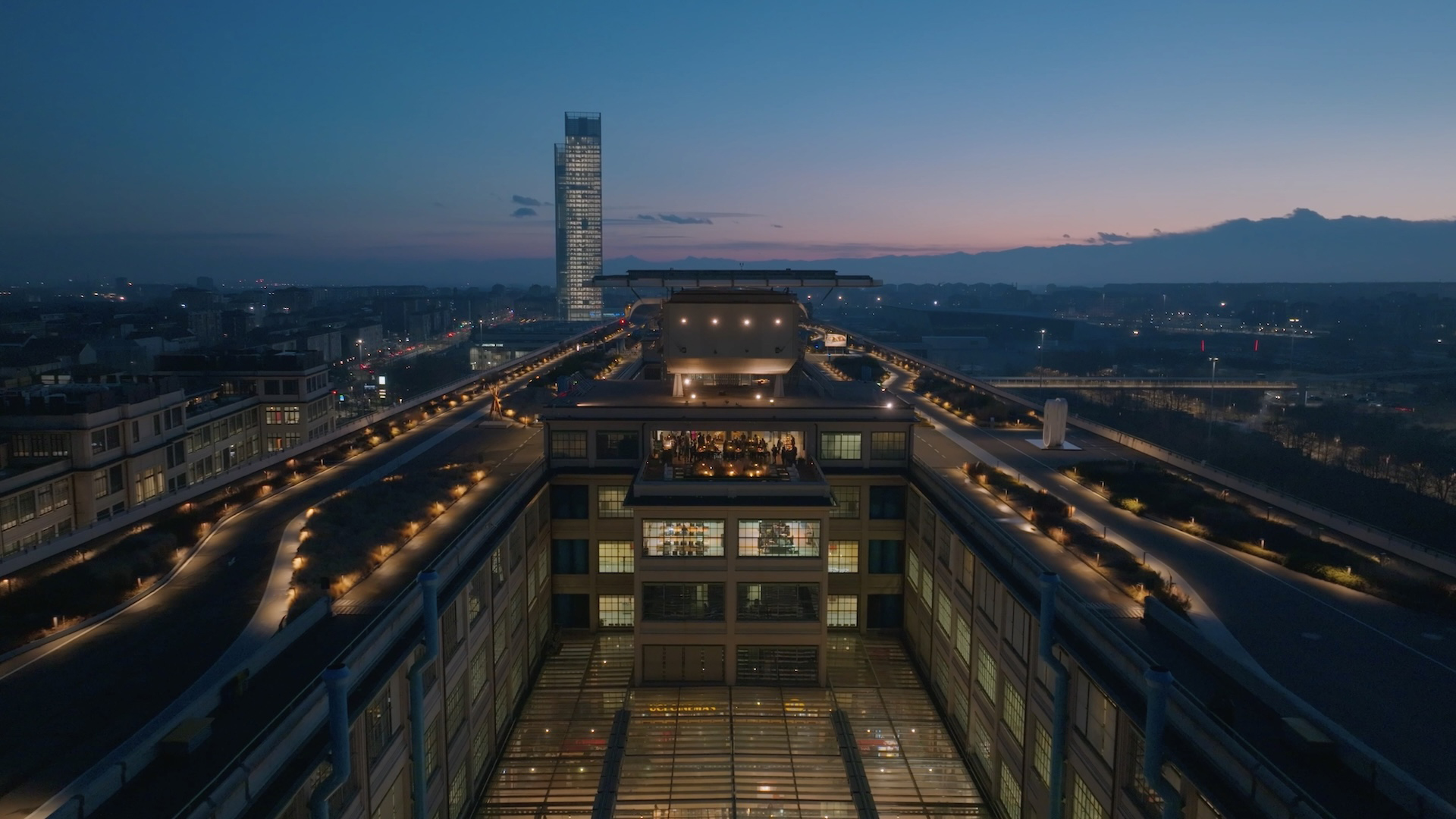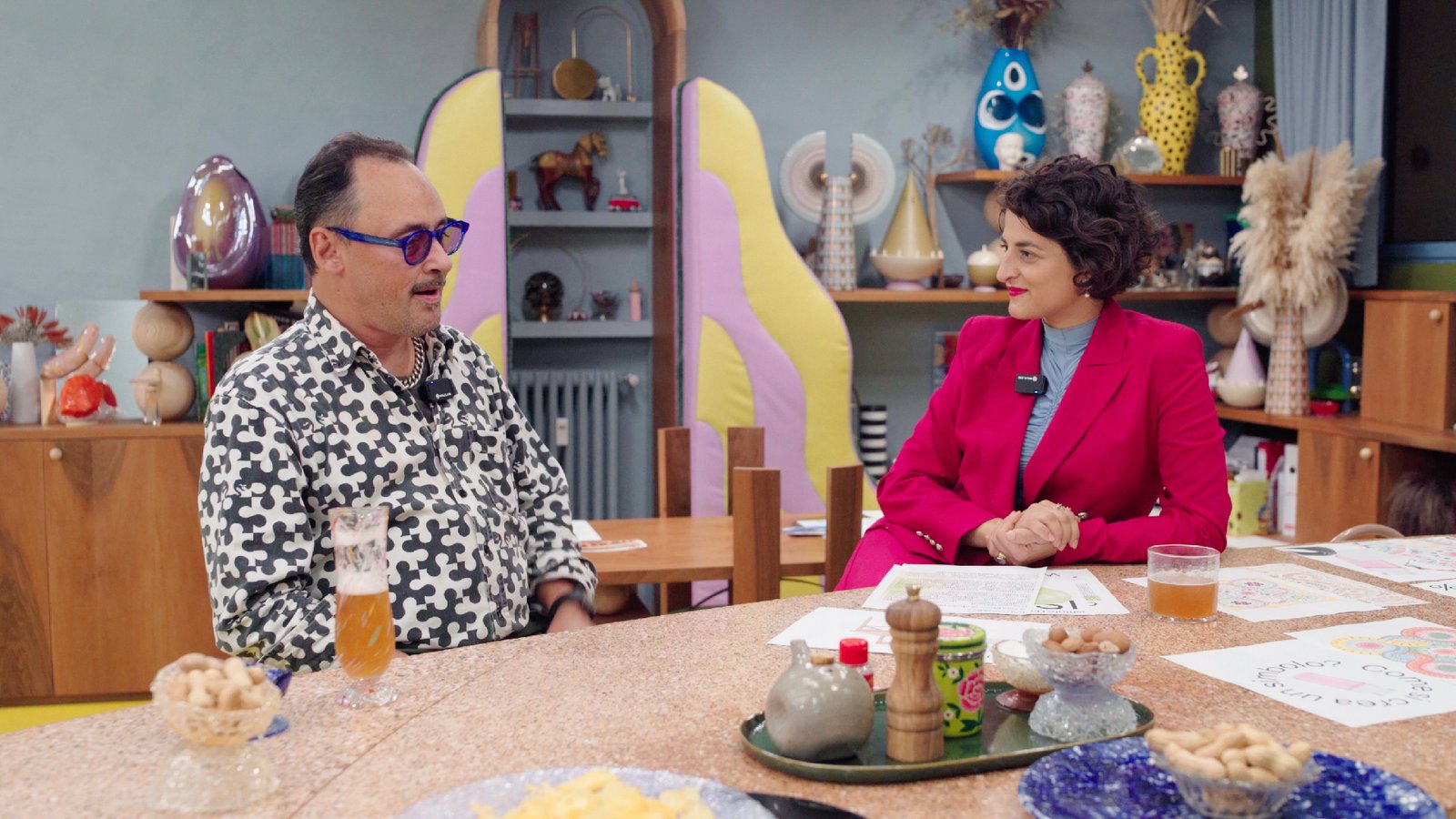
Health is a Culture (Health is Culture).
How much do we frequent care spaces? What is our physical and emotional sensation when we are inside and we are waiting for a visit, an outcome, or we are chaperones? Often, but not always fortunately, we find ourselves in spaces that are cold, noisy, dispersive, full of cracks in the walls, uncomfortable, and without an identity.
Several studies and accounts in the scientific literature show how our psycho-physical state alters when we enter places where we are in danger of getting lost or have to prepare for a visit that we might want to postpone1, as if it were precisely a life or death sentence2.
But what if instead we could be in a cozy, bright, low-noise environment adorned with works of art? Could it impact and provide relief to those who live in these places?
But it is necessary to make a premise: Spaghetti Boost, as a benefit society and promoter of artistic co-creation, and Carolina Zarrilli, PhD student in Medical Humanities, meet with the need to narrate issues that address culture in the care pathway, collecting national and international attempts and results and making them usable with the will to be promoters and incubators of similar interventions.
In this paper we are going to make a first review of terminology and state of the art in order to start with a basis of common awareness and knowledge of what is meant by rethinking care environments always giving as support practical and visual cases with the purpose of making tactful all these issues that seem to be far away from us but actually affect us all as parts of the community.

The scientific literature does not give a clear, unambiguous and effective definition of design interventions of care environments through art forms. The debate is general and speaks of humanization of care spaces, art in the hospital, setting, or caring for the patient's environment.
Often, these interventions are confused with art therapy, which is instead the use of art in therapeutic activities conducted in groups or individually. It is certainly a benefit and a strategy for so many conditions such as Alzheimer's3 or Parkinson’s4.
Here we will demonstrate the rethinking of care environments with actions involving sound design, colors, materials, microclimate, directions, nature, and cultural interventions.
These interventions impact the three users who experience these spaces on a daily basis, namely patients, caregivers, and staff. Below a chart5 that can visually summarize the effect for the three categories:

From the table above, it can be seen that this can also have a significant effect on welfare and the very high expenses that our health care system incurs on a daily basis.
These issues encapsulated in the concept of cultural welfare and culture and wellness were studied by Professor Roger Ulrich in the 1990s, who had noticed how landscape art had a great clinical result on patients and health care workers' welfare. Hence he configured 12 pillars of re-consideration of environments that would later be defined with the methodology of evidence-based design6.
 Khoo Teck Puat Hospital, Grand Hall, Singapore, 2021
Khoo Teck Puat Hospital, Grand Hall, Singapore, 2021
Ulrich bases his reflections on concepts and historical reconstructions that would later be grouped into the thinking of patient-centered medicine, which seeks to focus on the patient as a complete human being and not on the disease and thus the cure. To put it bluntly, it is no longer a matter of fixing, as a mechanic does to the part of a machine, but of caring for the whole garden as a gardener would. To define this process more scientifically, there are two main models that deal with the disease-health pair.
As the years passed, especially after the Enlightenment and the advent of science, the view of medicine and its centrality changed. Different approaches, including the biomedical and the biopsychosocial7 approach became established. The former is traced back to a Cartesian view, in which disease was at the center, the physician was in charge of curing it and differentiating body from spirit. It arises with industrial society, in which disease was a target to be isolated, understood and eradicated. This led to medicine specializing by organs and apparatuses; consequently, it distanced the physician from the person and his or her totality. The second was developed by George Engel in the 1970s. He introduced a revolutionary vision, in which the patient is placed at the center of his psychophysical relationships with the context and is characterized by environmental, social and cultural conditions. It is understood how organ problems, psychological, social and family aspects influence the evolution of the disease.
Interest in the combination of art and healing places dates back to ancient Greece with the Asclepias, therapeutic facilities integrated into nature. From early on there was a realization of the relationship with nature for the path to healing8. The Asclepiums were divided into surgical areas like a modern-day health city. Inside, there were facilities dedicated to art, sculpture, a gymnasium, and a theater-and this was to amplify the possibilities for interaction among the patients and the therapeutic value of the Asclepium. In the Middle Ages, the hospital was a place for the sick and the needy, while in the Renaissance, with scientific medicine, it became a place of healing. Hospital buildings became more specialized, adopting cross-shaped floor plans for functional and symbolic reasons. Despite increasing medicalization, art remained important, as evidenced by commissioned works, for example Piero della Francesca at S. Sepolcro or in the Ospedale degli Innocenti in Florence. The sick were immersed in beauty. With the Enlightenment, the need for hygienic environments became apparent, leading to the creation of autonomous, institutionalized hospitals such as the Policlinico in Milan, which integrated artistic elements to promote patient well-being. The idea is clear: architecture also serves to heal by inspiring those who stay there with a sense of pleasant well-being. Gardens are manicured and palms, pines and roses are planted.
This awareness circulated throughout Europe. Indeed, Florence Nightingale in her paper Notes on Nursing published in 1859 describes the need for beauty for patients, even if only by looking out the window or having a bouquet of flowers in the room: People say the effect is only on the mind. It is not. The effect is also on the body. As little as we know about the way we are affected by shape, color and light, we know that [flowers] have an actual physical effect9. The variety of shapes and brilliance of colors in objects presented to patients are actual means of healing. Nurse Nightingale considered this necessity on the same level as hospital hygiene, since the perception of the result was so objective as to confirm its undoubted veracity. To further reinforce this thesis, in 1935 the Treccani encyclopedia speaks of the "psychological factor,"10 of "making the place more welcoming and evocative”11 and of "garnished hospitals, with parks and gardens"12: "Everything is studied so that the sick person is in a serene and peaceful environment, so as to create for him a state of mind that facilitates his recovery”13
 Roberto Giussani, Luca Meneghel, Gianfranco Rota, Humanitas Gavazzeni ward with Canaletto's blow-up, project works in words, 2018, Bergamo
Roberto Giussani, Luca Meneghel, Gianfranco Rota, Humanitas Gavazzeni ward with Canaletto's blow-up, project works in words, 2018, Bergamo
Another turning point of change and awareness was definitely the pandemic period. Physicians and all staff first experienced even more what it means to live in isolation, in closed and bare spaces.
The testimony of Dr. Albano, an anesthesiologist at Humanitas in Bergamo, in his volume I giorni più bui14, sums up exactly the issues we are addressing: in the ICU, Albano, would move the beds of newly awakened patients in front of a reproduction of a Canaletto so that they could observe and admire it. Often the patients even unconsciously told about the painting, and when cured they would declare that they wanted to go to Venice to see the landscape in reality. He recounts in the volume how the hospital garden and the Accademia Carrara's blow-ups of paintings in the various passing spaces were essential to enjoy a moment of relief in that endless rush of those tragic months.
For this very reason, several personalities in the medical-scientific world call for embracing this period as an auspicious time to implement cultural interventions.
It has been explained that the place where therapies take place can influence the outcome of treatment by helping to improve the patient's condition; we now want to give practical examples of positive distraction during a therapy, which Ulrich defines as follows: an environmental element or feature that arouses positive feelings, maintains attention and interest without fatiguing or stressing the individual, and thus can block or reduce worrisome thoughts15.
The first case to be brought is that of Chelsea and Westminster Hospital in London. The CW+ foundation is involved in innovative projects that integrate art or culture within the hospital. It also organizes artist residencies that aim to put a lens on certain aspects of hospital life or to make the training of medical students more concrete still through drawing. Here we want to mention the case of Rippling Senses, by Zheyuan Zhang, a dual-screen digital artwork that uses body movement and facial recognition sensors to generate bespoke artworks created by an artificial intelligence algorithm as they pass through a corridor in the facility. The intent is to create curative art that interacts with people in an intriguing way, counteracting negative emotions and inducing positive ones, in effect creating a distraction16.
 Zheyuan Zhang, Rippling Senses, Chelsea and Westminster Hospital, 2022, London
Zheyuan Zhang, Rippling Senses, Chelsea and Westminster Hospital, 2022, London
Another interesting intervention is the one carried out at the Pope John XXIII Hospital in Bergamo in 2018, which commissioned a composition for the intensive care unit from Lorenzo Senni, an electronic music producer. Canone Infinito has a soft, gentle sound that is intermittently activated and can be heard in the corridors accompanying those working or relatives waiting for feedback on the health status of their loved one. It has been verified how the music calms and relaxes agitated people. This is also immediately reflected in communication with the referring physician, which is more peaceful and less aggressive17.
A final case, which considers more the naturalistic cultural apparatus is the Khoo Teck Puat, a hospital in Singapore18. The building stands next to Yishun Pond, a large lake park. Its strategic location allows patients to enjoy the view of the park. The hospital has planted terraces, rooftop vegetable gardens that supply the canteens, and a green courtyard that, similar to a forest, spreads upward within it. Energy efficiency, combined with rich vegetation and the use of the site's environmental features, transforms the "place of illness" into a "place of healing," making the hospital a garden of beneficial power fully integrated into the city and making it a welcoming public space frequented in common spaces by the entire neighborhood.
 Khoo Teck Puat Hospital, central garden transformed into Shangri-La, Singapore, 2013
Khoo Teck Puat Hospital, central garden transformed into Shangri-La, Singapore, 2013
After this contextualization of terms, cases and reconstructions, what can one do as a first concrete step? Definitely listen to the needs of one's surroundings, overturn preconceptions about these places, and get active in creating beauty with objects already in the spaces. It is good to remember that the primary goal is to improve the quality of life. These interventions are not intended to cure, but only to support ongoing treatment; but even a few seconds of relief can be a positive outcome for us as designers in this area.
 Shannon Mcgrath, The Creature sculpture and mural with marine themes, entrance to the Royal Children's Hospital in Melbourne, 2012
Shannon Mcgrath, The Creature sculpture and mural with marine themes, entrance to the Royal Children's Hospital in Melbourne, 2012
Cover image: Gareth Gardner, Reuben Foundation Maternity Centre, Adam Nathanial Furman Artwork, Chelsea and Westminster Hospital, Londra, 2020
Sources:
(1) Robert Gifford, Garling Tommy (2006). Wayfinding and Environmental Stress. Journal of Environmental Psychology, Milano: Elsevier, Amsterdam, 2006.
(2) M. Luongo (2011). Ho vinto una Biopsia, Firenze: Emmebi Edizioni 2022.
(3) Allan K., Killick J. (2000). Undiminished possibility: the arts in dementia care. Journal of Dementia Care
(4) Ettinger T., Berberian M., Acosta I., Cucca A., Feigin A., Genovese D., Pollen T, Rieders J,Kilachand R, Gomez C, Kaimal G, Biagioni M,Di Rocco A, Ghilardi FM and Rizzo J-R (2023), Art therapy as a comprehensive complementary treatment for Parkinson’sdisease. Front. Hum. Neurosci.
(5) P. Cusack, C. Isles e L. Lankston (2010). Impact of visual art in patient waiting rooms: survey of patients attending a transplant clinic in Dumfries. Journal of the Royal Society of Medicine Short Reports, p. 1-5; R. Roger (2009). Effects of viewing art on Health Outcomes. Putting patients first, pp. 141-143; Z. Bood (2021). The effects of art therapy on anxiety, depression, and quality of life in adults with cancer: a systematic literature review. Supportive Care in Cancer, 29: p. 2289-2298; J. Scott (2019). The Healing Arts, Londra: Unicorn 2019, p. 88-89.
(6) R. Ulrich e L. Gilpin (2003). Healing Arts. Putting patients first.
(7) Enzo Grossi (2017). Evidenze cliniche dei rapporti tra cultura e salute. Economia della cultura, Milano: Il Mulino 2017.
(8) Romano Del Nord (2012). Una nuova attenzione all’ambiente nei luoghi di cura: il ruolo dell’architetto. Fondazione Bracco, p.10.
(9) F. Nightingale (1859). Notes on Nursing, Londra: Bookseller to the Queen 1859.
(10) A. Canezza, G. Marcovigi e A. Paolini (1935). Ospedale. Enciclopedia Treccani.
(11) Ibidem.
(12) Ibidem.
(13) Ibidem.
(14) G. Albano (2020), I giorni più bui. Milano, Piemme.
(15) J. Rollins (2021). Purpose-build art in Hospitals, Wagon Lane: Emerald Publishing Limited, 2021, p.102.
(16) Per questo argomento, vedi il sito Internet: Future Hospital - CW+ (cwplus.org.uk).
(17) C. Giraud (2018). Musica in ospedale. A Bergamo, Lorenzo Senni compone una traccia audio per la terapia intensiva. Artribune.
(18) L. San Chiu (2020). A Healing Space - Creating Biodiversity at Khoo Teck Puat Hospital , Singapore: Alexandra Health 2020.
She is a cultural designer and doctoral candidate in Medical Humanities and Welfare Polices. Her common thread is caring for people's wellbeing, whether it is behind a stage with Grato Cuore, Rosetum Jazzfestival, a professorship at the Mohole School or research to rethink the design of healthcare environments through artistic interventions. With Spaghetti Boost he will address various topics on the combination of art and sanctity in international and national contexts, proposing how to concretely innovate it.



